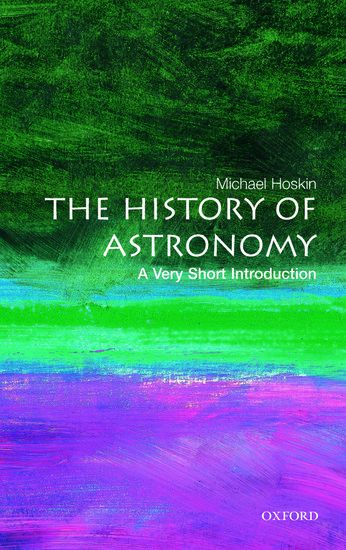Home >
A Very Short Introduction >
The History of Astronomy (Science)
A Very Short Introduction | Science
The History of Astronomy
ISBN: 9780192803061
Series: A Very Short Introduction
The History of Astronomy (Science)
A Very Short Introduction The History of Astronomy (Science) Media > Books > Non-Fiction > Education Books Expect Delays of Up to 4 Weeks| Order Below |
ISBN
9780192803061 (10-digit ISBN: 0192803069)
- Description
- Key Features
- Series Description
- Table of Contents
- The only short introduction to this subject
- Focuses on the major developments of the 17th, 18th, and 19th centuries: Copernicus, Kepler, Galileo, Newton and beyond
- Looks at astronomy in antiquity: the Egyptians and the Greeks: Aristotle, Plato, Eudoxus, Hipparchus
- Final chapter on the directions that the subject has taken since 1950
Astronomy, perhaps the first of the sciences, was already well developed by the time of Christ. Seventeen centuries later, after Newton showed that the movements of the planets could be explained in terms of gravitation, it became the paradigm for the mathematical sciences. In the nineteenth century the analysis of star-light allowed astrophysicists to determine both the chemical composition and the radial velocities of celestial bodies, while the development of photography enabled distant objects invisible to the human eye, to be studied and measured in comfort. Technical developments during and since the Second World War have greatly enlarged the scope of the science by permitting the study of radiation.
This is a fascinating introduction to the history of Western astronomy, from prehistoric times to the origins of astrophysics in the mid-nineteenth century. Historical records are first found in Babylon and Egypt, and after two millennia the arithmetical astronomy of the Babylonians merged with the Greek geometrical approach to culminate in the Almagest of Ptolemy. This legacy was transmitted to the Latin West via Islam, and led to Copernicus's claim that the Earth is in motion. In justifying this Kepler converted astronomy into a branch of dynamics, leading to Newton's universal law of gravity. The book concludes with eighteenth- and nineteenth-century applications of Newton's law, and the first explorations of the universe of stars.
Oxford's Very Short Introductions series offers concise and original introductions to a wide range of subjects--from Islam to Sociology, Politics to Classics, Literary Theory to History, and Archaeology to the Bible.
Not simply a textbook of definitions, each volume in this series provides trenchant and provocative--yet always balanced and complete--discussions of the central issues in a given discipline or field. Every Very Short Introduction gives a readable evolution of the subject in question, demonstrating how the subject has developed and how it has influenced society. Eventually, the series will encompass every major academic discipline, offering all students an accessible and abundant reference library.
Whatever the area of study that one deems important or appealing, whatever the topic that fascinates the general reader, the Very Short Introductions series has a handy and affordable guide that will likely prove indispensable.
Please note: As this series is not ELT material, these titles are not subject to discount.
1: The Sky in Prehistory
2: Astronomy in Antiquity
3: Astronomy in Middle Ages
4: Astronomy Transformed
5: Astronomy in the Age of Newton
6: Exploring the Universe of Stars
Epilogue
Further Reading
Astronomy, perhaps the first of the sciences, was already well developed by the time of Christ. Seventeen centuries later, after Newton showed that the movements of the planets could be explained in terms of gravitation, it became the paradigm for the mathematical sciences. In the nineteenth century the analysis of star-light allowed astrophysicists to determine both the chemical composition and the radial velocities of celestial bodies, while the development of photography enabled distant objects invisible to the human eye, to be studied and measured in comfort. Technical developments during and since the Second World War have greatly enlarged the scope of the science by permitting the study of radiation.
This is a fascinating introduction to the history of Western astronomy, from prehistoric times to the origins of astrophysics in the mid-nineteenth century. Historical records are first found in Babylon and Egypt, and after two millennia the arithmetical astronomy of the Babylonians merged with the Greek geometrical approach to culminate in the Almagest of Ptolemy. This legacy was transmitted to the Latin West via Islam, and led to Copernicus's claim that the Earth is in motion. In justifying this Kepler converted astronomy into a branch of dynamics, leading to Newton's universal law of gravity. The book concludes with eighteenth- and nineteenth-century applications of Newton's law, and the first explorations of the universe of stars.
Key Features
- The only short introduction to this subject
- Focuses on the major developments of the 17th, 18th, and 19th centuries: Copernicus, Kepler, Galileo, Newton and beyond
- Looks at astronomy in antiquity: the Egyptians and the Greeks: Aristotle, Plato, Eudoxus, Hipparchus
- Final chapter on the directions that the subject has taken since 1950
Series Description
Oxford's Very Short Introductions series offers concise and original introductions to a wide range of subjects--from Islam to Sociology, Politics to Classics, Literary Theory to History, and Archaeology to the Bible.
Not simply a textbook of definitions, each volume in this series provides trenchant and provocative--yet always balanced and complete--discussions of the central issues in a given discipline or field. Every Very Short Introduction gives a readable evolution of the subject in question, demonstrating how the subject has developed and how it has influenced society. Eventually, the series will encompass every major academic discipline, offering all students an accessible and abundant reference library.
Whatever the area of study that one deems important or appealing, whatever the topic that fascinates the general reader, the Very Short Introductions series has a handy and affordable guide that will likely prove indispensable.
Please note: As this series is not ELT material, these titles are not subject to discount.
EASY ORDER FORM
PRICES LISTED INCLUDE CONSUMPTION TAX
Price Before Tax:
¥1,790


